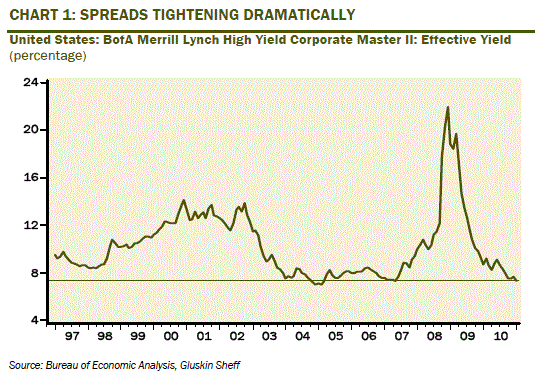After an incredible 85% rally since the 2009 lows there are some signs that the high yield bond market is beginning to look expensive. In a search for yield investors have driven high-yield bond risk premiums just below their historical average of 5.1%. Risk premiums can be tricky in an environment such as the current one. Risk premiums are historically high at 70% of yield so there is an argument to be made that the Fed’s extraordinary actions are distorting valuations. Average yields, meanwhile are sinking to all-time lows. High yield bonds, at 7.1% based upon the Merrill Lynch U.S. High Yield Master II Constrained Index, are just shy of the record low yield of 6.81% recorded in December 2004. In addition issuance is ballooning. According to Fitch high yield issuance surged 67% in 2010 to $252.4B vs 2009 levels of $151.5B.
In his recent outlook for the bond market Jeff Gundlach of DoubleLine stated that high yield corporates were never more expensive:
“Junk bonds have never been richer….At best, they’ll hold their own against competing investments.”
Martin Fridson, Global Credit Strategist, BNP Paribas Investment Partners disagrees:
“Whatever the future may hold, pundits who are bearish on high yield cannot justify their stance on grounds of valuation….Given where the fundamentals are, the spread is actually a touch more than it should be.”
David Rosenberg of Gluskin Sheff, in yesterday’s market commentary, offers a more balanced perspective:
“The overall not-too-hot/not-too-cold macro backdrop is obviously very constructive for the high yield market. These companies have radically restructured their balance sheets over the past two years to the point that the volume of debt to refinance by 2014 has plunged 44% to $482 billion. Default risks have accordingly declined.
At the same time, the sector trades at a premium and the yield at 7% is flirting with all-time lows. Total returns in the past two years have come to total 87% versus 53% for the S&P 500. Last year’s darlings were the BRICS and now we see these markets faltering and escalating outflows from emerging market equity funds. Every dog has its day.
What is a bit scary is that inflows into high-yield funds are surging — almost $5 billion so far this year, which is over one-third of the 2010 intake. This is a bit worrisome from a contrarian standpoint, but I am at least heartened by the fact that portfolio managers in this sector (looking at the ICI data) have cash ratios now that are in excess of 6%. This is a much better cushion than they had going into the credit meltdown (when they were just at 4%, and at the worst of the crisis in late 2008, they were over 10% cash).
Spreads have tightened dramatically and are at levels we saw at the 2007 peak of the risk cycle. That said, they did get well below 300bps in each of the two prior bull runs so there may in fact be more juice left based on recent history but not a whole lot.”
As of the end of 2010 the junk bond default rate was 3.1%. That’s down from 13% in 2009. Moody’s expects that to fall to 1.9% this year, however, pressures will mount as the corporate debt burden increases in the coming years:
“A flood of US speculative-grade, nonfinancial corporate debt—almost $690 billion—is scheduled to mature during 2011-2015. Despite heavy new issuance in 2010, the maturities have fallen by only $100 billion from the roughly $800 billion noted in last year’s study. This indicates the recent robust new issuance in 2010 merely “kicked-the-can” of the pending refunding needs to a later date.
Near-term refunding needs are relatively modest, with just $26 billion maturing in 2011 and $67 billion in 2012—a welcome relief as the economy continues its slow recovery. But the big refunding need in 2013-2015 of approximately $600 billion poses a greater concern given the still somewhat weak economic recovery, a high unemployment rate that is expected to be about 9% at year-end 2011,11 and the prospect of higher interest rates in the future.”
All in all the risk trade in high yield appears to be on in 2011 barring an unforeseen economic downturn. It’s likely that moderate to high valuations combined with low default risk and reasonable funding needs will continue to feed the debt binge in high yield corporate bonds. This should make Ben Bernanke quite pleased as his goal of re-leveraging an overleveraged private sector comes to fruition. Whether or not this trend is sustainable is a totally different question and likely doesn’t have a happy ending.
Mr. Roche is the Founder and Chief Investment Officer of Discipline Funds.Discipline Funds is a low fee financial advisory firm with a focus on helping people be more disciplined with their finances.
He is also the author of Pragmatic Capitalism: What Every Investor Needs to Understand About Money and Finance, Understanding the Modern Monetary System and Understanding Modern Portfolio Construction.


Comments are closed.